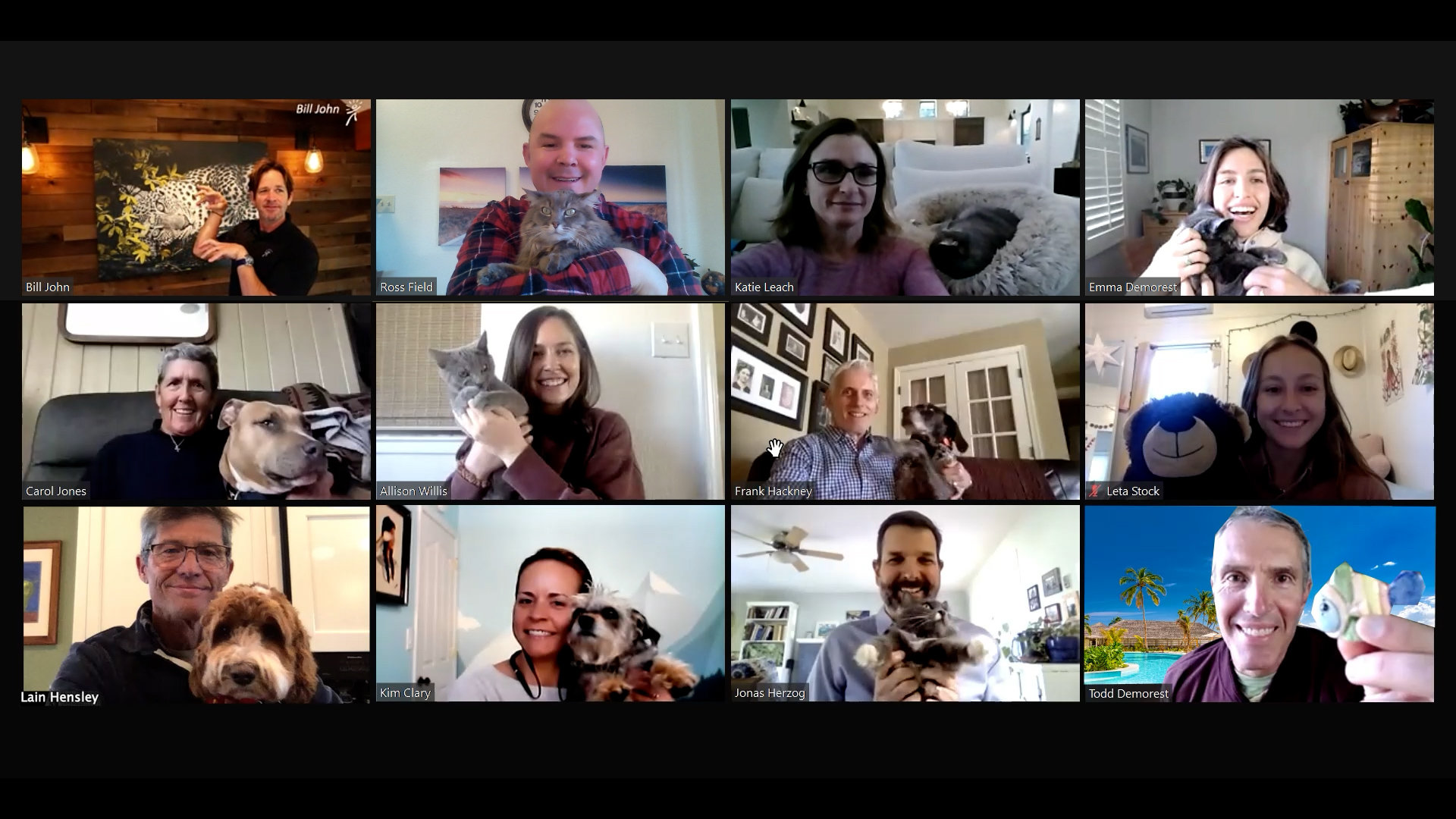Are Pets Welcome Intruders During Virtual Business Meetings?
A slightly biased study on the power of pets during the pandemic-induced work-from-home setting.
Recently, we were on an internal virtual teambuilding activity when Allison’s cat came bounding onto her screen. It had nothing to do with the online activity, so she apologized and quickly moved her feline out of view. That little cat-cameo in Allison’s pandemic office space changed the mood of the meeting and we began talking about the impact our pets have had on us, on our virtual teams, and on our business over the past year and a half. I was curious and formed a few questions that I wanted to find the answers to:
How often does it occur and what has been the impact of pets in virtual business meetings?
Is it a pet-peeve or a welcome distraction seeing a cameo cat or a disruptive dog on-screen?

We’ve gathered some interesting data, but I must disclose a personal bias. I am a California resident and co-owner of a teambuilding and leadership development organization Odyssey Teams, as well as a licensed Safari guide in South Africa. It is a strange combo, but not entirely unrelated. The Safari Guide credential came after extensive study of the plants, animals, ecosystems, geography and more in Southern Africa. I followed in my son’s footsteps after he completed a year-long guide-school. The inspiration for us both to learn more started with a family Safari eight years ago.
I have always enjoyed being in wild places but was never able to describe WHY until several months into my Safari Guide practical studies from January-February 2021 – during the grip of the pandemic. It was the best opportunity to immerse myself and try to comprehend the immense power that mother nature has on our well-being. My well-being. I learned A LOT.
I learned the dung beetle can push 1,148 times its own body weight and that termites are the most successful farmers on earth (they don’t eat plant matter – they regurgitate it in chambers called fungal gardens. It is this fungus they eat – not the plant matter). I learned that the seeds of some trees are only able to germinate by passing through the digestive tract of an elephant. I learned there are 27 different types of fig trees and 27 species of wasps. A 1:1 ratio of pollinator to fig tree. Exactly.
Wild places are harder and harder to find and the wildlife in those places is increasingly scarce. Sadly, and not surprisingly, our pets have become surrogates for us to find nature. Especially when we live far from it. Observing animals on Safari made me see nature – something more closely connected to ‘wild’ – in our yellow lab (Hank) back home.
Cats and dogs (or any pet) are a portal for us back to the wild place where we all came from. They represent something we need but have a hard time articulating. Why do serotonin levels increase when we pet a dog? Why are horses used for therapy? Why do we get our cameras out when we see a buck, a bear, a whale, a dolphin, or a hummingbird? Why are some of the best experiences correlated to the wild you have seen – in animals and in yourself?
Since our species has been upright with forward facing eyes, only a tiny fraction of this time has occurred where we have been walled-in, or asphalted-off, from nature.
Our pets are a gateway into all that we have forgotten. When we sit with them and when we observe them, they teach us how to be more ‘natural’. They challenge us to ‘need’ less and ‘be’ more without saying a word or judging us for having everything or nothing at all. Sometimes, our pets remind us of just how wild they are.
The African Wild Dog or Painted Wolf (Lycaon pictus) has the same social need as your dog. It is the most successful hunter (as a species) of all the mammalian predators in Africa because of its orientation towards teamwork. Your dog is literally on your team.
The African Wildcat (Felis lybica) looks exactly like a tabby cat but with slightly longer legs. Your cat is an independent soul, perfectly capable of catching its meal and leaving some for you. Though it needs you in that mysterious cat-like way. You don’t have to look deep into your cat’s eyes to see that their ‘wild’ and independence is just behind its affection for you.
When an elephant walks past a safari vehicle, or a cat walks across your colleague’s desk at a virtual business meeting, something happens if you’re paying attention. Something inside of you happens. It is a glimpse of presence, a sense of belonging and a sense of connection.
Or not.
The survey results indicate that for some people (15 percent), virtual business meetings are not appropriate for our wild-life surrogates. Our sample size was not robust, and the questions could have been more scientifically vetted for better measurement, however, we can draw some anecdotal conclusions and leave the deeper analysis for those who are further interested.
In life, in business, on teams and in families there are grey areas and things that we see differently. Some people are going to absolutely love seeing a pet in a virtual business meeting and some will be offended. Writing policies based on these extremes is difficult and we see that very few organizations have established pet-policies for their virtual business meetings.
96 percent of organizations are not touching it from a policy-perspective as it seems the safest bet is to give a little grace. We are all learning new ways to navigate a day ‘at’ work. For some, the Pandemic has been a sufferfest only tolerable because of the therapeutic value of our pets. According to this study (much more scientific than ours), “dog owners were significantly less depressed than non-pet owners during the COVID-19 pandemic”.
Their conclusion further explains:
“The COVID-19 pandemic has negatively affected diverse populations [129–134] and our results provide evidence that pet owners and potential pet owners have also been impacted. Our results show that pet dog owners were significantly less depressed than non-pet owners during the COVID-19 pandemic. They are attached and committed to their dogs and they reported more social support available to them. Our work adds to the corpus of scientific literature demonstrating that pet dogs may positively contribute to the wellbeing of owners during difficult times. However, more work is needed to better understand the relationship between pet ownership and social support as modulators of owner wellbeing. Future research should focus on people with low and moderate social support and include owners with diverse dog attachment levels.”
In our study, 72.5 percent of respondents indicated their own pet had barged onto the screen of one of their virtual business meetings, while 89% have seen a co-worker’s pet do a cameo appearance.
85 percent said that it neither bothered nor distracted them when seeing a co-worker’s pet join a virtual business meeting. US Representative, Anita Burroughs, admits her cats have made appearances during recent House Commerce And Consumer Affairs Committee hearings. At some point “The chair talked to her and said no animals in the room”. For Ms. Burroughs she offers “That’s part of the life we’re living right now, and pets are part of it, too. For me personally, it’s just calming having my animals sit next to me so I can pet them, and it doesn’t distract me in any way. I’m fully attentive to what’s going on.” See full article here: US Lawmakers Told to Keep Their Pets Out of Zoom Calls and Online Hearings
Pets are good conversation starters and have jump-started many relationships. “According to a survey by Purina, ‘Nearly 6 out of 10 surveyed say that they are likely to consider a person with a dog more attractive.’ What’s more, 54 percent believe their pet is the perfect conversation starter with someone they’re interested in. And if you’re into online dating, the survey also found that 1 in 3 people want to talk to someone that has their pet in their dating profile photo.” Read the full article here: Can your dog help you meet someone?
I digress. Suffice to say that pets are important to us for a variety of reasons. I think they are critical ambassadors in our disconnected (overly wired) world and might just play a key role in how we work remotely. They might just be the perfect ice-breaker activity for some teams.
Since Odyssey Teams’ work focuses on company culture, team dynamics and leadership development it was more than just interesting for us to examine the effects of pets in virtual business meetings and during our virtual teambuilding activities. Allison’s cat was more than welcome in our meeting and may be the inspiration to create a teambuilding event featuring your furry and feathered friends. Next time you see something domestically ‘wild’ in your virtual business meeting, call it out and have a discussion to see where your team is with it. Send us your observations/data and thoughts.
Here are the full results of our tiny survey from a biased observer:
Sample size: 80
Has your pet ever barged in on your camera/screen during a virtual business meeting?
Yes: 58 No: 22
Have you seen a co-worker’s pet barge in?
Yes: 71 No: 9
Does your company have a policy about ’No pets in/during virtual business meetings’?
Yes: 3 No: 77
Does it bother or distract you when you see a co-worker’s pet during a video call?
Yes: 12 No: 68
Written by Bill John, CEO and Co-Founder of Odyssey Teams
References:
https://journals.plos.org/plosone/article?id=10.1371/journal.pone.0260676#sec021
https://newscenter.purina.com/2016-02-11-Your-Ultimate-Wingman-is-at-the-End-of-Your-Leash
https://www.policygenius.com/pet-insurance/news/can-your-dog-help-you-meet-someone/







Leave A Comment
You must be logged in to post a comment.